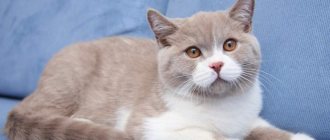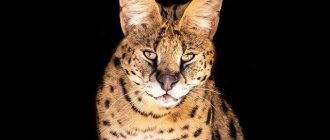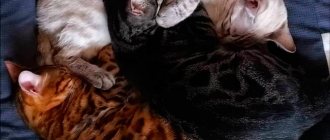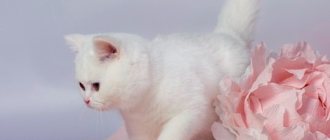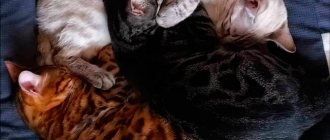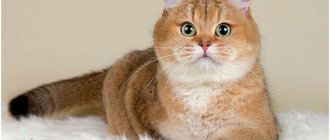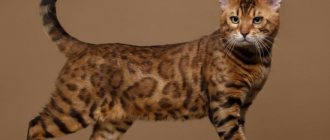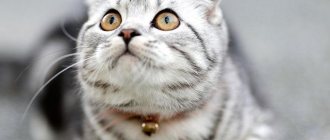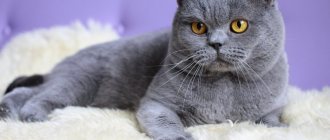02/22/2020 6,936 Interesting things about cats
Author: Olga
If you have decided to have a gentle, clean pet, then the British Chocolate cat requires special attention. The unique feature of these pets is their devotion to the owner. The cat can find something to do while you are not at home. However, this does not mean that he will not start to get bored. The kitten will be able to entertain not only itself, but also you. The chocolate color will not leave anyone indifferent. The photo serves as excellent proof of this.
[Hide]
British standard
At the present stage, approximately 60 different fur colors have been recorded. A kitten can be blue, black, cream, lilac, red, tortoiseshell, etc. Among the newest and rarest, a cat with chocolate-colored fur occupies a special place. You should know that if stripes or marks of a different color are present, the four-legged furry is discarded.
British chocolate cats are rare. This can be attributed to the fact that a similar color is found only in those animals that have Color Point ancestors with the same coat color in their family. Chocolate British cats have a calm, friendly character. Their short fur is not capable of causing much trouble when cleaning rooms.
How to choose an unusual kitten
A British shorthair of chocolate color or a fold-eared cat of the same color will have to be selected taking into account the characteristics of the breed.
The English cat is characterized by stable health. Just look at the activity of the kittens, their appetite and curiosity (withdrawal will begin to appear a little later).
If a pair of parent cats is incorrectly selected, the Scottish Fold breed sometimes exhibits osteochondrodysplasia, a congenital hereditary disease of the skeleton and osteochondral system.
Kittens with this disease are afraid of sudden movements that can cause pain. Therefore, you should only buy a fold-eared kitten from a nursery or from a breeder with a good reputation.
It is useful to get to know the parents and, if possible, to look at their grown-up children from other litters. As a rule, the same pair consistently produces almost identical offspring.
Looking at them, you can predict the color, size, and even the character of newborn kittens.
A British Shorthair kitten is recommended for people who work a lot and are rarely at home. An hour and a half is enough for them to fully satisfy the need for communication with their pet. And the British also like this daily routine.
Scots are great for homebodies, families with children, and those who enjoy endless cat games. And the brown color always evokes the admiration of guests and a sense of pride among the owners. And the cats themselves are imbued with their own uniqueness and are happy to show off their rich, thick fur the color of fragrant British chocolate.
Genetics of colors
The genetics of the formation of cream color in British cats is closely related to another primary color – red.
- The O gene is responsible for the red color. It has one feature that is unusual for other colors - the gene attaches to the X chromosome, which affects the sex of the future kitten.
- In British female kittens, the defining characteristic is the XX chromosomes, and in boys, the XY chromosomes. It turns out that two O genes can join the chromosomes in a cat, but only one can attach to a cat.
- Each gene is found in a dominant (O) or recessive (o) form.
- In the first case, the combination of OO dictates the obligatory output of red-colored offspring, the OO variant gives the hereditary instruction of a non-red (black) color, and OO extends to tortoiseshell color (in female kittens).
- For boys, the situation is different - one X chromosome and only two options: red and black.
- Cats inherit the color gene from their mother's side. In the case of OO, everything is clear - the animal will definitely be red. The second scenario (oo) is also simple - the British will be black. But in the case of Oo, the baby will take on the dominant red color from the mother cat. Therefore, more red male cats are born than girls.
The second gene, which forms the cream color, is designated D (dilutor, dilutor). In the cat's genetic map, it affects lightening and comes in two forms: dominant D (no lightening) and recessive dd.
At the final point, black turns into brown, chocolate into lilac, cinnamon into fawn, and red into cream. Inheritance of color occurs only from parents to offspring.
It is important! Cream British kittens are only born when both parents have the D gene.
What is color and how are new colors developed?
The color of a cat refers to the color of the coat and the pattern on it. In general, domesticated cats are distinguished by an incredible variety of colors, unlike their wild relatives. There are not so many main genes responsible for the color of a mustachioed pet (solid color, lighteners, patterns, etc.), but their combination and various combinations create an endless number of options. Two genes are responsible for each trait, one of which is received from the mother, the other from the father. The task of a competent breeder is to correctly identify the necessary genes (dominant or recessive) and carefully select them to develop the desired shade.
Fur of four-legged friends
The main color of animals is chocolate color. It has a deep and rich shade. According to the standard, there should be no tabby marks, spots or light-colored hairs at all. The chocolate pigment should be distributed evenly throughout the coat. In this case, the hairs should be soft and short.
Kittens take a long time to acquire a truly chocolate shade. In some cases, the formation process can continue for 15 months. Sometimes the fur can acquire a brown tint, as shown in the photo. However, over time, kittens lose it.
British cats can have fur of different shades of chocolate. Therefore, it will be possible to find pets whose fur coat may be the color of a bitter or milky dessert. A kitten of this color is very popular today. In this, it is not inferior to its purple and blue counterparts.
Types of merle colors among the British
This color belongs to a group of colors called tabby (from the name of the striped fabric brought to England from Baghdad). The peculiarity of this pattern is the continuity of lines and the uniqueness of the pattern for each individual. Thanks to the efforts of felinologists, today the British marble coat is represented by many varieties.
Black marble
The main background of the coat is dark gray, the stripes have a pronounced black tint. There is a black outline around the eyes and nose, the color of the eyes is brown-orange.
British black marble shades are highly prized by animal lovers.
Black marble on silver
Charcoal stripes and spirals are symmetrically arranged on a silver background. There are dark spots near the eyes and the red-brown nose.
Black marble on silver - exquisite colors of British cats
Black marble on gold
The main color of the coat is copper-golden, the stripes have a black or dark brown tint. The eyes are most often green or yellow.
The British with the “black marble on gold” color look very presentable
Lilac marble
The silver fur coat is decorated with patterns of lavender or peach undertones. There is also a lavender rim around the nose and eyes. The iris is yellow or pale brown.
British cats with a lilac-marble hue are quite unusual
Tortoise marble
The main background can be silver-red or silver-brown, while the spots and patterns remain black or dark brown. The eyes are often yellow or greenish. The color is characteristic only of females; in rare cases it is found among males. Cats with this color cannot have offspring due to genetic characteristics.
Tortoiseshell marble involves adding reddish shades to the main color scheme
Chocolate marble
The fur coat is the color of milk chocolate, the pattern is dark brown. The eyes and nose are outlined with thick chocolate eyeliner. The color of the iris is from yellow to golden brown.
Chocolate Marble is a common color option among the British.
Bicolor
The main color with spots is diluted with white inserts on the paws, chest and belly. Eyes can be yellow, brown or green.
Bicolor color is also found among British harlequins.
Red marble
The light red fur of the main background is decorated with spots and streaks of a rich red hue. The eyes are orange, brownish-golden.
Red merle is a red British breed with merle patterns on their coats.
Red marble on silver
It is distinguished by a silvery tone of the main background, the spots have a light red color. The fur around the eyes is white, the nose is pink. The eyes are yellow or golden.
Red marble on silver - a spectacular coat color for the British
Cream marble
The main background has a shade of creme brulee, and the spots tend to be peach. There are white hairs around the eyes and a pink nose. Eyes yellow or gold.
Cream marble is a very delicate shade of the fur of British cats.
Blue marble
Silver coat with smoky gray stripes and spots, dark gray lining around the nose. The eyes are not circled and have a brown-golden tint.
The British in the shade of “blue marble” look noble
How to determine the color of a British cat
The color of a British cat is determined visually, and the final decision is made only upon reaching the age of 1–1.5 years - until this time, the coat may fade and change. An expert can give the most accurate assessment. A specialist must study the main color, the presence of rejection characteristics, pattern and shading (if any) - all this can really be done by eye, knowing the requirements for the numerous colors of British cats.
There is such a procedure as conducting a genetic test (using any biological material, most often blood). It also relates to the determination of color, but not of an adult animal, but of its future offspring. Based on the results of the analysis, it is possible to determine the carriage of certain genes, which will allow you to select a partner to obtain the desired color. So, for example, any British dog can get a lilac coat color, but only if both have a recessive form of the d gene. Such a test is of great importance for breeding work.
British cats are not only the familiar gray plush pets, this breed boasts a huge list of possible colors. Various monochromatic (solid) variants can be called classic, and active breeding work has made it possible to create the most incredible combinations, in particular, tortoiseshell multi-color colors with a tabby pattern.
Solid colors
Solid (other names are solid, solid) colors must meet the only requirement - uniformity. Any colored inclusions or minor patterns are defects that are not missed by specialists.
When knitting, light colors are more valuable, dark ones have a low price. The wool is completely devoid of shine, the skin is soft, plush, pleasant to the touch. Any impurities of foreign color are unacceptable.
Important! Even the fingertips and nose should match the shade of the coat. Eyes – golden-copper
Black color
Black British cats are extremely rare. Therefore, their price differs significantly from the price of animals of standard colors. The fur of such cats is hard, with a very pronounced shine. To comply with the quality standard, the cat's body must be completely black, this applies to both the nose and paws. The main eye color is green, but gold and copper shades are acceptable.
Important! It happens that with age the color becomes not as bright as at the beginning, and more washed out
Black British cat
White color
White is a difficult color to achieve, but the standard does not allow any impurities. Such cats are very valuable and are in demand among breeders. Their disadvantage is possible congenital deafness. If white British people still have eyes of different colors, they are valued incredibly highly, since there is a sign associated with them that good luck comes to the house with them.
The cream or beige kitten is considered the most popular among people who breed British kittens. The uniformity and depth of the soft peach shade looks great. Only individuals of this variety are suitable for crossing.
Chocolate color
The British chocolate-colored cat was bred by breeders not very long ago, so it is rare. But he has already received a huge number of prizes at exhibitions and competitions, so all breeders dream of getting such a kitten into their collection.
Interesting! The final shade of the coat is formed only when it reaches 1.5 years.
Lilac color
Lilac British kittens are very popular due to their unusually colored coats. There are 3 color options available:
- light pinkish or lilac;
- medium intensity purple;
- dark, like coffee with milk.
The lighter the lilac color of a British cat, the higher it is rated. Up to 6 months, foreign impurities may be present; later they resolve. The eyes are copper, orange, the nose and paws are in accordance with the coat. Lilac-colored Britons are extremely beautiful and showy.
Cinnamon
Cinnamon, or cinnamon color, is often confused with chocolate. However, the cinnamon-colored skin is softer, lighter, with a slight accent of bronze or copper. A feature allowed by the standards: the fur around the eyes and mouth is lighter than elsewhere. The nose and fingertips are light and nude.
The breed is new, valuable, for breeding it is important to have animals of different sexes of this color (which can cost a pretty penny). The presence of the cinnamon color gene can only be determined after several generations
Resembles lilac kittens, but with lighter fur. The differences are that the shade is close to sandy and creamy. The paws and nose must match. Often the color of the skin is pinkish-beige, this is rated higher, which means it costs more.
Interesting! When crossing two fauns, the kittens will be lighter.
Appearance Options
The Chocolate Briton has a strong build and a wide chest. Cats usually have short legs and a round head. It should be noted that the cat has fairly wide cheekbones. A kitten or cat's ears are straight. They are located quite widely.
The cat has eyes that are dark orange or copper in color. In this case, the more saturated the shade, the better. Purebred kittens have dark brown fur.
For a long period of time, chocolate-colored cats could only be found among representatives of oriental breeds. We are talking about Siamese, Oriental, Burmese cats. The British cat got its chocolate shade thanks to Persian Colorpoints of the corresponding color.
An interesting thing is that chocolate kittens have become more popular over time compared to their counterparts, thanks to which they acquire a beautiful shade.
Tabby
The Tabby (Tabby) color allows cats to have patterns of different directions, sometimes the coat can even be ticked or marbled. The main signs of a Tabby are the letter M located on the animal’s forehead (scarab sign), dark stripes near the eyes and on the cheeks, and rings on the neck and chest.
The brindle (mackerel, striped) color option is considered the most common among tabbies. A line of the main coat color runs along the entire spine. From the name it is clear that the pattern is made up of dark stripes. A clear and separated pattern is a requirement made by specialists. If this rule is violated, the animal is rejected. The eyes are bright - red and copper.
The British spotted tabby cat is distinguished from others by horizontal dark lines extending from the eyes. There are also stripes on the animal’s cheeks. A dark broken line runs along the spine, and on the sides there are a large number of dark spots and dots. The tip of the tail is dark, with striped rings running along its entire length.
Spotted tabby color
The British merle tabby color is considered classic. It is characterized by light silvery sides with dark spots or stripes. The pattern looks very impressive, since it is not interrupted or intersected anywhere. On the back of the head there is a pattern in the shape of a butterfly, and the letter M, standard for the color, is located lower than usual, closer to the nose. Eye color is copper with smoky rims. The British Marbled cat looks expensive and elegant.
We suggest you familiarize yourself with: List of horse names, how to name a stallion
Interesting! Small kittens may have an undivided merle color. When they reach the age of 2 months, the pattern becomes clear.
Torby (tobry) is a color that combines two color varieties: patterned and tortoiseshell tabby. A spotted, marbled or striped pattern arrangement is allowed. The standard assumes that the British tortoiseshell tabby color has rings on the neck, stripes on the legs, the letter M on the forehead, which is characteristic of all tabbies, and rings along the entire length of the tail. In kittens, identifying this type of pattern is problematic, but as they grow older, at about 12 months, the lines become clearer.
For many, this coloring of a cat looks like it is uniform, but it is not. The color is original, since the top part of the coat looks like a light dusting, and this shade is identical to the color of the lower part of the undercoat. Most often these colors are blue, black and chocolate, but others are also allowed.
Peculiarities of chocolate British participation in cat shows
If a British chocolate cat exactly meets all breed standards, is healthy and has no external physical defects, and also has the necessary documents (pedigree), then it can take part in any cat shows.
Preparations for exhibition events are carried out in advance:
- The animal is bathed (if the coat looks oily) with a special shampoo. It is recommended to use conditioner (same brand).
- Clean ears and eyes.
- Carefully trim the claws.
- Using a special brush and toothpaste, brush your pet’s teeth (2-3 days before the event).
To prevent the rich brown color from fading or fading, the animal should not be exposed to direct sunlight. Tinting and tinting wool is strictly prohibited.
The show animal must meet all breed standards
Individuals with the following deficiencies are subject to disqualification:
- white inclusions, stripes, spots or lighter undercoat (brownish or gray);
- eyes of an inappropriate shade or rim around the iris;
- not brown color of the nose and paw pads;
- excess or insufficient number of fingers;
- undershot or overshot (more than 2 mm);
- tail defects (bends, creases);
- the coat is too long or very fluffy.
Our neighbor has a black cat who leads a free lifestyle. He spends most of the warm season outside, free-ranging. He comes home only to eat. Since in the summer he is often exposed to the sun, his fur fades greatly and becomes an unsightly brownish-brown color. In winter, when it is frosty outside, he sits at home and after molting again becomes blue-black.
British character
The British cat and cat are distinguished by their affectionate nature. They become quite attached to their owner. However, they are able to easily endure separations. The main thing is that they are not too long. By temperament, chocolate-colored pets are calm and balanced.
They can only show character when eating. In this regard, they are quite demanding. The cat is able to insist that food be served on time. Therefore, it is important to immediately determine the feeding regimen and follow it.
The video clearly shows what they are like - British chocolate cats.
Where to buy kittens?
We all have a natural desire to save money, and unscrupulous people often take advantage of this. Buying a purebred animal is no exception to the rule; today such deceptions are not uncommon.
A purebred kitten cannot be cheap; if you are offered a show-class kitten, then you should immediately suspect something is wrong. Either they openly want to deceive you, or you are faced with an inexperienced cat lover who doesn’t even know all the ins and outs about the breed. In this case, immediately refuse the purchase.
Do not take kittens only based on an advertisement on the Internet; they can sell you a British kitten without documents. How much such a kitten costs is not even worth finding out, because no one can guarantee that both parents are purebred and have no defects in their pedigree.
The best purchasing option would be to contact a specialized nursery, where they will not only sell you a purebred animal, but will also give you detailed advice on raising and feeding a kitten.
Upbringing
If you are attracted to kittens of a given breed and color, and after looking at numerous photos and videos, you decide to get a pet, you should understand that you will practically become a parent for it. Chocolate fluffies are no different from other little four-legged friends. They love to be active, playful, and want to receive affection and praise from their owners.
Kittens are very curious creatures. In their quest to know everything, they are capable of crawling around the entire house. A kitten can charm quite easily, as evidenced by various photos. Spontaneity and sweet habits and habits help him in this. However, from a young age he must be taught discipline. This will help get rid of numerous problems and protect your pet from all kinds of injuries.
Kittens must understand immediately what can and cannot be done. Hitting and swinging at the fluffy is not recommended. You should stop pranks with your voice. This will help not embitter the baby. If you approach your upbringing wisely, kittens will not put out their claws, bite, crawl on clothes or damage furniture. Don’t forget that both cats and cats of popular colors need affection and praise.
How many breeds are there?
There are not as many cat breeds as there are dog breeds, but there are still plenty to choose from. Even an avid cat lover cannot give the exact figure, because there are many associations and clubs in the world involved in the classification and exhibition of cat breeds. And their accepted breed standards may differ from each other, and if in one association a breed is considered recognized, then in another it will be only a branch of another.
On average, today there are over a hundred cat breeds, and together with the varieties there will be all seven hundred. Among them there are both large and small breeds, as well as with different colors and coats.
The British breed is recognized as one of the most popular in the world, and how much a kitten of the British species costs depends on a number of factors, which we will discuss below.
Plain (solid)
The color of Scottish Fold cats is monochromatic and they should not have any other color. The fold-eared cat can be of the following colors: white and black, chocolate and lilac, blue and red, cream, fawn and cinnamon. The most popular color in the world among solid Scottish cats is blue. These are the majority of cats.
White
The white Scottish Straight cat can have different eyes, from blue and bright orange to rich amber and copper. Kittens of this variety remain white for the rest of their lives. If kittens have spots, then an adult cat remains white for the rest of its life.
Black
The Scottish Fold black cat is mostly bright in color. A couple of white hairs are acceptable, but if the cat has large red and brown patches, then it is not a purebred.
Black Scottish Fold cats should be bright black in color and their ears, like all fold-eared cats, should be pressed to the head, unlike straight-eared cats. A straight-eared black cat always has its ears erect.
Chocolate
The chocolate Scottish Fold looks impressive. The chocolate color is quite rare. Brown fold kittens should have a smooth, uniform coat of chocolate color. The dark brown coloring adds nobility to the cat.
A brown cat gets this color if he has chocolate, chocolate bicolor or chocolate color points in his pedigree. Chocolate Scottish kittens always delight their owners. They look very cool against a light background.
Lilac (lavender)
A lilac long-eared cat gets this color if he has either lilac color points or lilac in his pedigree. The lilac coloration goes well with orange, copper or amber colored eyes and a light brown nose. This color is also called coffee with milk.
Blue color (blue)
The Scots Blue can have a coat color of many shades of blue. Some cats may have a fur color closer to gray, and some closer to blue. Each hair must be saturated, then the coat will be perfectly blue.
Small pets have different patterns that disappear after a few months. Three months after birth, their eyes may be copper-colored.
Red (red)
Red Scots are a very rare breed. The ginger Scottish cat, like the ginger kitten, has a tail defect in the form of unevenly colored fur. In red-haired pets, red is sometimes more dominant than red.
These cats may have patterns on their foreheads and limbs, but this is not considered the norm. The Scots, unlike the British cat breed, can give birth to either a red fold-eared cat or a straight-eared cat.
Cream
The soft peach coat of a lighter color gives this cat an elegant appearance. At first glance, they are very similar to the red ones, but if you look closely, you can clearly see the difference. Cream hairs are lighter. Smooth patterns on the paws and tail are acceptable, but leopard spots are not acceptable.
Faun (deer)
The coat of kittens of this breed is a very interesting color. This shade should not be confused with lilac, which has a lilac tint. The paw pads and nose of these cats are beige-pink.
Cinnamon
At first this color can be confused with chocolate, but this is not so. This look is lighter and softer. Its nose and pads are beige or pink-brown.
Where is the price higher?
If you ask how much a British kitten costs in Moscow or another metropolis, and compare the prices with the cost of kittens in the regions, you will be unpleasantly surprised. Pedigree animals in the capital will cost more than kittens from the regions.
The reason for this is clear - everything is more expensive in Moscow. But another question arises: is it worth buying kittens from the regions or paying more, but buying in the capital? And here not everything is clear.
In big cities, prices may be higher, but there is also more choice. In addition, you can find breeders who have been breeding this breed for more than one year and regularly participate in exhibitions. This means that you will be able to purchase not just a kitten from breeding parents, but also, possibly, champions of your breed. But you need to be prepared for the high cost of the animal.
In small regions there is another extreme - there are practically no professional breeders, and there is no need to talk about participation in exhibitions.
Breeding
Many breeders take the sale of cats for breeding very seriously, and therefore the prices for them are much higher than those individuals that are sold only as pets. That is, for castration and sterilization. British merle dogs cost on average 20-25 thousand rubles for sterilization, and several times more expensive for breeding. Depending on the reputation and popularity of the nursery, prices can reach up to 100 thousand rubles, but it will be a real, elite and purebred kitten.
If you want to purchase a marble kitten for further mating, then you should understand that it must have all the documents and pedigree, otherwise it will be incredibly difficult to find a worthy purebred pair.
And it is also worth understanding that for breeding British marbled cats, a fairly large room for keeping them is recommended. Before you decide to breed British marble cats, it is recommended that you carefully weigh the pros and cons. You should only purchase a kitten from a trusted nursery with a good reputation.
You can give a marble boy or girl a very original name that will appeal to all household members in the house. Even if the animal was not purchased for mating, it will delight the whole family for many years, because on average the British live 17 years.
About British cats, watch the following video:
Origin story
The breed appeared in Great Britain in the 19th century. About 10 years were spent on selection. The color was obtained by crossing recessive forms of British cats of chocolate and blue shades. According to statistics, only a quarter of pets are born with a similar shade. About 30 years ago, felinologists officially accepted the color.
The belief that the color was created by crossing a Scottish fold cat and a marbled cat is incorrect. The result of this will be the birth of kittens with disorders at the genetic level.
The British Lilac cat is not a separate breed, but belongs to British cats with short hair; the main difference with other representatives lies in the shade of the coat.
There is no breed of British Fold. There are only short/long-haired British and lop-eared/straight-haired Scots.
History of the breeding of British chocolate
Breeders were not involved in the targeted breeding of brown fur in British cats . This color is not so common; it is characteristic of eastern representatives of the cat family (Burmese, Oriental, Siamese, etc.). The goal of the breeding work was to obtain color-point color in plush cats, for which they were crossed with color-point Persians.
The purpose of breeding the breeders was the color point color, and the chocolate color turned out to be an accident
The first chocolate Briton was born by chance in the 80s of the last century. But the color was so deep and luxurious that later breeders began to strive for a pure dark brown shade. British cats of this color are very popular.
What to feed
Food from the family table is not suitable for your pet. There is not much information on what to feed small British kittens. Contrary to popular belief, cats should not be fed fish 7 times a week. A photo of a British kitten by month shows the growth and external changes of the baby.
There are also age restrictions on the baby menu. What is the best way to feed a British kitten:
- lean boiled meats, exclude pork;
- cottage cheese, kefir and sour cream;
- boiled vegetables;
- cereals;
- boiled fish: no more than once a week.
What to feed 1st month
The kitten will be satisfied with its mother's milk for up to a month. At the beginning of the 4th week, the cat’s food dishes should be placed next to the cat’s bed. Babies will be attracted by the smell of food, then you can gradually introduce complementary foods: once a day. They give natural products or wet specialized food for kittens. The crumbs easily cope with food, bringing the food to 3-5 rubles per day. Growth and weight gain are monitored simultaneously: the kitten’s weight should correspond to the age norm. At 6 weeks the animal usually stops drinking cat milk.
What to feed 2nd month
At home, conditions of detention are not always followed, but you need to know what to feed a British kitten at 2 months. Babies at 2 months finally refuse mother's milk. Supplementary feeding is carried out up to 5-8 r. per day. Factory canned food is diluted with small portions of dry food
What to feed the 3rd month
A British kitten has been confidently eating supplementary food since three months. It is necessary to weigh the baby and observe the excess weight gain. Follow the recommendations on what to feed a British breed kitten at 3 months and monitor the functioning of the gastrointestinal tract. There is no need to give milk to the cubs at this age.
What to feed the 4th month
At 4 months, complementary feeding is reduced to 5 times a day. Monitor the replenishment of clean water in the bowl: the baby must drink. You can contact a specialist to create a rational menu.
The baby's diet should include vitamins and minerals, calcium for growth and strengthening of bones. Industrial feeds take into account the ratio of nutrients and the age of the kitten. British kitten 4 months old in the photo.
Royal canin food is known to the British. What food is best for British kittens: one that will help their little bodies grow and develop, maintain the shine of their coats and help with oral hygiene. Dry foods are formulated to optimize teething for pets. What can you feed a British kitten from commercial food: the Royal Canin company produces food for kittens containing a vitamin-mineral complex; they also offer a cat's milk replacer.
